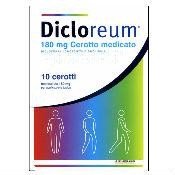
Dicloreum Local Anti-Inflammatory is a medicated patch based on diclofenac sodium (180 mg per patch) indicated for the local treatment of pain and inflammation. It is particularly effective in the treatment of muscle and joint pain of traumatic or rheumatic origin, such as strains, bruises, sprains or tendonitis. The patches gradually release the active ingredient directly on the affected area, offering a prolonged anti-inflammatory and analgesic action.
ACTIVE INGREDIENTS
Active ingredients contained in Dicloreum Local Anti-Inflammatory 10 Medicated Patches 180mg - What is the active ingredient in Dicloreum Local Anti-Inflammatory 10 Medicated Patches 180mg?
One 180 mg medicated plaster contains: Diclofenac hydroxyethylpyrrolidine 180 mg (equivalent to 140 mg of Diclofenac sodium). Excipients with known effect: 14 mg of methyl parahydroxybenzoate (E218), 7 mg of propyl parahydroxybenzoate (E216), 420 mg of propylene glycol and 2.8 mg of perfume (containing amyl cinnamal, amyl cinnamyl alcohol, benzyl alcohol, benzyl benzoate, benzyl salicylate, cinnamal, cinnamyl alcohol, citronellol, d-Limonene, eugenol, farnesol, geraniol, hexyl cinnamic aldehyde, hydroxycitronellal, isoeugenol, linalool, methyl heptine carbonate). For the full list of excipients, see section 6.1.
EXCIPIENTS
Composition of Dicloreum Local Anti-inflammatory 10 Medicated Patches 180 mg - What does Dicloreum Local Anti-inflammatory 10 Medicated Patches 180 mg contain?
Gelatin, povidone, D-Sorbitol 70% solution, kaolin, titanium dioxide, propylene glycol, methyl parahydroxybenzoate (E218), propyl parahydroxybenzoate (E216), disodium edetate, tartaric acid, dihydroxyaluminium aminoacetate, sodium carmel, sodium polyacrylate, 1,3-butylene glycol, polysorbate 80, perfume, purified water, synthetic felt, plastic film.
DIRECTIONS
Therapeutic indications Dicloreum Local Anti-inflammatory 10 Medicated Patches 180mg - Why is Dicloreum Local Anti-inflammatory 10 Medicated Patches 180 mg used? What is it for?
Local treatment of painful and inflammatory conditions of rheumatic or traumatic nature of joints, muscles, tendons and ligaments.
CONTRAINDICATIONS SIDE EFFECTS
Contraindications Dicloreum Local Anti-Inflammatory 10 Medicated Patches 180mg - When should Dicloreum Local Anti-Inflammatory 10 Medicated Patches 180mg not be used?
Hypersensitivity to diclofenac, acetylsalicylic acid or other nonsteroidal anti-inflammatory drugs (NSAIDs) or to any of the excipients of the finished product, as well as to isopropanol. Patients who have experienced asthmatic attacks, urticaria or acute rhinitis after taking acetylsalicylic acid or other nonsteroidal inflammatory drugs (NSAIDs). Damaged skin, regardless of the type of lesion: exudative dermatitis, eczema, infected lesion, burns or wounds. Third trimester of pregnancy and breastfeeding (see section 4.6). Patients with active peptic ulcer. Children and adolescents: use in children and adolescents under 16 years of age is contraindicated.
DOSAGE
Quantity and method of taking Dicloreum Local Anti-Inflammatory 10 Medicated Patches 180mg - How do you take Dicloreum Local Anti-Inflammatory 10 Medicated Patches 180mg?
For cutaneous use only. Dosage: The product should only be applied to intact, healthy skin and should not be applied while bathing or showering. Diclofenac medicated plaster should be used for the shortest possible time in relation to the indication for use. Adults: The usual dosage regimen is 1 or 2 patches (or any other frequency evaluated in clinical trials for a specific product) per day (one application every 12 or 24 hours) for up to 14 days (or any other number of days evaluated in clinical trials for a specific product). If no improvement is seen following the recommended treatment period, a doctor should be consulted. Children and adolescents under 16 years: The use of this medicated plaster is not recommended in children and adolescents under 16 years of age because there are insufficient data to evaluate the safety and efficacy of the medicinal product (see section 4.3). In adolescents aged 16 years and over, if the product is required for a treatment period longer than 7 days for pain relief or if symptoms worsen, the patient or the adolescent's relatives are advised to consult a doctor. Elderly: This medicinal product should be used with caution in elderly patients as they are more susceptible to side effects (see section 4.4). Patients with hepatic or renal insufficiency. For the use of diclofenac medicated plasters in patients with hepatic or renal insufficiency, see section 4.4. Method of administration: Cut the sachet containing the medicated plaster as indicated. Take out a medicated plaster, remove the plastic film used to protect the adhesive surface and apply the plaster to the joint on the painful area. If necessary, the plaster can be held in place with an elastic band. Carefully close the sachet by pressing the edge where the drawstring is located. The plaster must be used whole.
CONSERVATION
Storage Dicloreum Local Anti-Inflammatory 10 Medicated Patches 180mg - How do you store Dicloreum Local Anti-Inflammatory 10 Medicated Patches 180mg?
Store at a temperature not exceeding 30 degrees C.
WARNINGS
Warnings Dicloreum Local Anti-inflammatory 10 Medicated Patches 180mg - About Dicloreum Local Anti-inflammatory 10 Medicated Patches 180mg it is important to know that:
If diclofenac medicated plasters are used on large areas of skin and for a prolonged period of time, the possibility of systemic adverse events cannot be excluded (see the Summary of Product Characteristics of the systemic formulations of diclofenac). The medicated plaster should only be applied to intact, healthy skin and should not be applied to broken skin or open wounds. The plasters should not come into contact with the eyes or mucous membranes. Undesirable effects may be minimised by using the lowest effective dose for the shortest duration necessary to control symptoms. Do not use with an occlusive dressing that does not allow air to pass through. Treatment should be discontinued immediately if a skin rash develops after application of the medicated plaster. Do not administer another medicinal product containing diclofenac or other NSAIDs topically or systemically at the same time. Although systemic effects should be limited, the medicated plaster should be used with caution in patients with renal, cardiac or hepatic impairment, history of peptic ulcer or inflammatory bowel disease or haemorrhagic diathesis. Nonsteroidal anti-inflammatory drugs should be used with particular caution in elderly patients who are more predisposed to adverse effects. Patients should be advised not to expose themselves to direct sunlight or sun lamps for approximately one day after removal of the medicated plaster in order to reduce the risk of photosensitivity. Dicloreum local anti-inflammatory contains: methyl parahydroxybenzoate (E218) and propyl parahydroxybenzoate (E216) which may cause allergic reactions (possibly delayed). 420 mg of propylene glycol per patch which may cause skin irritation; a perfume containing in turn allergens (amyl cinnamal, amyl cinnamyl alcohol, benzyl alcohol, benzyl benzoate, benzyl salicylate, cinnamal, cinnamyl alcohol, citronellol, d-Limonene, eugenol, farnesol, geraniol, hexyl cinnamic aldehyde, hydroxycitronellal, isoeugenol, linalool, methyl heptine carbonate) which can cause allergic reactions.
INTERACTIONS
Interactions Dicloreum Local Anti-inflammatory 10 Medicated Patches 180mg - Which medicines or foods can modify the effect of Dicloreum Local Anti-inflammatory 10 Medicated Patches 180 mg?'
Since systemic absorption of diclofenac following the use of medicated plasters is very low, the risk of developing clinically significant interactions with other medicinal products is negligible.
SIDE EFFECTS
Like all medicines, Dicloreum Antinflammatory Locale 10 Medicated Patches 180 mg can cause side effects - What are the side effects of Dicloreum Antinflammatory Locale 10 Medicated Patches 180 mg?
Adverse reactions are listed by frequency, the most frequent first, using the following convention: common (>= 1/100, < 1/10); uncommon (>= 1/1,000, < 1/100); rare (>= 1/10,000, < 1/1,000); very rare (< 1/10,000); Not known: cannot be estimated from the available data. Infections and infestations. Very rare: rash with pustules. Immune system disorders. Very rare: hypersensitivity (including urticaria), angioneurotic oedema, anaphylactoid reaction. Respiratory, thoracic and mediastinal disorders. Very rare: asthma. Skin and subcutaneous tissue disorders. Common: rash, eczema, erythema, dermatitis (including allergic dermatitis and contact dermatitis), pruritus; rare: bullous dermatitis (e.g. erythema bullosum), dry skin; very rare: photosensitivity reactions. General disorders and administration site conditions. Common: administration site reactions. Reporting of suspected adverse reactions. Reporting suspected adverse reactions that occur after authorisation of the medicinal product is important. It allows continued monitoring of the benefit/risk balance of the medicinal product. Healthcare professionals are asked to report any suspected adverse reactions via the national reporting system at https://www.aifa.gov.it/content/segnalazioni-reazioni-avverse.
PREGNANCY AND BREASTFEEDING
If you are pregnant or breast-feeding, think you may be pregnant or are planning to have a baby, ask your doctor for advice before taking Dicloreum Local Anti-inflammatory 10 Medicated Patches 180 mg
Pregnancy: The systemic concentration of diclofenac, compared to oral formulations, is lower after topical administration. Based on the experience of treatment with systemically administered NSAIDs, the following is recommended: Inhibition of prostaglandin synthesis may adversely affect pregnancy and/or embryo/foetal development. Results of epidemiological studies suggest an increased risk of miscarriage and of cardiac malformation and gastroschisis after use of a prostaglandin synthesis inhibitor in early pregnancy. The absolute risk of cardiac malformations increases from less than 1%, up to approximately 1.5%. The risk was considered to increase with dose and duration of therapy. In animals, administration of prostaglandin synthesis inhibitors has been shown to result in increased pre- and post-implantation loss and embryo-foetal mortality. Furthermore, an increased incidence of various malformations, including cardiovascular, has been reported in animals given prostaglandin synthesis inhibitors during the organogenetic period. During the first and second trimester of pregnancy, diclofenac should not be given unless clearly necessary. If diclofenac is used by a woman attempting to conceive, or during the first and second trimester of pregnancy, the dose should be kept as low and duration of treatment as short as possible. During the third trimester of pregnancy, all prostaglandin synthesis inhibitors may expose the fetus to: cardiopulmonary toxicity (with premature closure of the ductus arteriosus and pulmonary hypertension); renal dysfunction, which may progress to renal failure with oligo-hydroamniosis; the mother and neonate, at the end of pregnancy, to: possible prolongation of bleeding time, and an anti-aggregating effect which may occur even at very low doses; inhibition of uterine contractions resulting in delayed or prolonged labor. Consequently, diclofenac is contraindicated during the third trimester of pregnancy. Breastfeeding: Like other NSAIDs, diclofenac passes into breast milk in small amounts. However, at therapeutic doses of diclofenac medicated plasters, no effects on the infant are anticipated. Due to the lack of controlled studies in breastfeeding women, the product should be used during breastfeeding only under the advice of a healthcare professional. In this circumstance, diclofenac medicated plasters should not be applied to the breasts of nursing mothers, nor elsewhere on large areas of skin or for a prolonged period of time (see section 4.4).

























